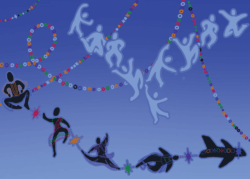As you walk into the new Royden. B. Davis, S.J. Performing Arts Center it is impossible not to be taken aback by the wide-open spaces, long white-tiled halls, and state-of-the-art theatrical equipment. The new space mirrors the vast expansion of the theater program at Georgetown in the past year. At the heart of this expansion is the completion of the Center.
Student theater groups such as Nomadic Theater, Mask & Bauble, Georgetown Players and the Black Theater Ensemble, for the most part, have existed well before the Program in Performing Arts. Mask & Bauble is the longest continually running student theater society in the country.
“Independence has been the hallmark of Georgetown student theater for 154 years,” James Salandro (COL ‘03), a former member of Nomadic theater, said.
Now student theater is not the sole theatrical force on campus. The creation of the Program in Performing Arts in 2003 has added a new element to the Georgetown theatrical community.
“The hope and plan in the next number of years is that PPA will evolve away from the Department of Art, Music and Theater to become its own Department of Performing Arts,” Karen Berman, professor of theater at Georgetown wrote.
Next year the program will inaugurate a theater major, according to Maya Roth, director of theater at Georgetown, something that the department has have been hoping to offer since the initial creation of the program.
With the completion of the Davis Center, theater has both student and professional outlets on campus. The question is whether the emergence of the Davis Center will undermine or bolster the well-established culture of student-led theater on campus.
Students groups and Georgetown faculty have been working together for a number of years. Berman said she has been working as the artistic advisor to all of the student theater groups of Georgetown University for the past 14 years, but until recently, she was the only one.
According Roth, two positions have been added to the Program in Performing Arts over the past three years—the Technical Director of Theater Program, and a Visiting Professor. Currently, two professors, Natsu Onoda and Michael Philippi, share the position of Visiting Professor. The program has also added part-time faculty memebrs.
“There’s a lot more mentorship going on [this year], so it’s not just me as the advisor for all of these plays … there’s a lot more professional assistance if people want it, it’s not required,” Berman said.
This has largely been helped by the staff increase at the Program in Performing Arts over the past three years, Berman said.
According to Kate Noland (COL ‘06), associate producer of Nomadic Theater, all of Georgetown’s theater students, faculty and student theater groups sit down together throughout the spring of each year and map out the upcoming season. During these meetings a theme is selected for the forthcoming shows.
In addition, during these meetings, the Program in Performing Arts extends the opportunity of collaboration to the student theater groups. In the past, the program has collaborated with the Black Theater Ensemble, Mask & Bauble, and most recently Nomadic Theater, in Dr. Korzack and the Children.
“Collaborations are a big part of our identity [in the Black Theater Ensemble] … our origins are within collaborations,” Dionne Young (COL ‘04) said.
Collaborations allow the student theater groups to work with professional actors and set designers, as well as state-of-the-art equipment. But Noland said there has been fear that the students will simply fade to the background of these productions. Noland was the stage manager for Dr. Korzack and the Children, Nomadic Theater’s collaboration with the Program in Performing Arts.
“We ended up getting a [student] production manager and an executive production manager who was a member of the [Program in Performing Art] staff, and at first we really weren’t happy with that and were really concerned that the students were going to get sidelined,” Noland said.
Both Roth and Berman agree, however, that in the past these collaborations have proved to be beneficial for all, rather than elevating one group above another.
“It was really a wonderful learning experience where we were able to experiment with the different styles of process,” Berman said.
Noland also found that collaborating with the Program in Performance Art was ultimately fruitful.
“[The collaboration] ended up turning out really well … as the student grew into her position the executive production manager decreased his involvement in the actual production of the show,” Noland said.
The student theater groups and the Program in Performing Art do not limit their interactions to these collaborations, but rather, there is an on-going conversation between the groups.
The primary difference between the student groups and the Program in Performing Arts lies in their goals. “The academic theater program is [meant] to teach theater whereas Nomadic has a social awareness focus,” Noland said. “The difference in focus sends us off in different directions.”
Yet, while the campus theater groups have disparate motives, they are ultimately brought together by the common goal of improving students through theater, according to Berman, director of Dr. Korzack and the Children.
“The whole thing is about student development and growth and leadership,” Berman said.
This leads to a great deal of mixing. “People on the boards of Nomadic and Mask & Bauble were the leads in the plays A Winter’s Tale and Our Country’s Good,” Berman said. “There’s a sense of a lot of overlap and growth and a sense that we are all together. We’re all a community.”
“I’ve also been impressed by the communication between the groups, and my interactions with them have been very inspiring and positive,” Onoda, who is just now completing her first year of teaching of Georgetown, said.
Others fear that the overlap between the two groups is not necessarily a positive thing.
” [Student and Faculty theater groups are so similar] and that is my biggest concern,” Anna Johansson (COL ‘06), a former board member of both Mask & Bauble in Nomadic Theater, said. “We’re always doing the same [kind of] show and pulling in the same people.”
Because student theater still has limited access to the stages of the David Performing Arts Center, Johanssen said, many students might choose to do a PPA show instead of a student show.
Yet, while the performance space was constructed for the theater degree programs, its usage is not limited to this focus.
In February, Mask & Bauble hosted the Donn B. Murphy One Act Festival on the Devine stage of Davis Center. The festival was not a collaboration, but rather had a student producer and a faculty mentor. Next year, according to Berman, Nomadic will also be putting on an independent production on one of the center’s stages with a faculty mentor.
“It won’t be like the collaborations, but rather have a student director,” Berman said.
In the Performance Center, the halls are lined with numerous rooms each with a specific role. The center contains a scene shop, a costume shop and several rehearsal spaces, as well as the student groups’ inboxes.
Students have had complete access to many of these features of the Performing Arts Center since its opening, and they have taken advantage of them.
“Sets that once took weeks to make now take a few days,” Berman said. “On any given night you can find two or three of the student groups taking advantage of this new space.”
“The availability and resources [of the Davis Performing Arts Center] are fantastic,” Brandon Evan (COL ‘08), who is currently an active member of the student theater groups, added.
With the University providing the resources, students provide the passion. Student theater has “a certain sense of freedom … it’s our blood, sweat, and tears,” Courtney Baker (SFS ‘05) a former member of Mask & Bauble, said.
Many students are now applying this same work ethic to their involvement in the Program in Performing Arts shows, as well as their own productions. This is beginning to take its toll on them.
According to Evan, the same students are working on all of the shows. Because of the number of shows put on each year, students are forced to choose which productions to work on. “Working on shows all the time is tiring,” Evan said.
Commonly, students are drawn to Program in Performing Arts shows because of the high quality of the final product, and this takes people away from the student theater productions, Johansson said. But the experiences of faculty and student theater are not identical.
“Student theater focuses on the process… with faculty it’s more important to have a good product,” Johansson said.
Mask & Bauble as well as Nomadic Theater have both taken steps toward securing their identity separate from that of the Program in Performing Arts. Berman, artistic advisor to Mask & Bauble, said the group has made the conscious decision to continue to perform in Poulton hall.
Noland, meanwhile, said that Nomadic Theater keeps its independent identity through its board selection. “We pick people devoted to the club … people who stay true to the Nomadic goal of social change,” Noland said. Noland also said that the group keeps up strong recruitment in order to keep the group running strong.
The University of Chicago provides an example of a theater program in which both students and faculty play an integral role in campus theater.
“The vast part of the theater program is student-run. While there is an academic program called Theater and Performance Studies, it is administrated by the same people who work for the student organization University Theater,” Dan Kimmel, the publicity manager of University Theater at the University of Chicago, wrote in an email.
“UT [University Theater] is a student-run group. Although there is a professional staff who oversee the operations (and, as mentioned, administer the Theater and Performance Studies department), students propose the shows that make up our seasons. Proposals are submitted to an elected committee of eight students, who vote on the best ones to make up a season,” Kimmel wrote.
Onoda, who taught in the Chicago’s well-respected program before coming to Georgetown, noted similarities between theater at the two campuses.
The biggest similarity between the two theater programs is the fact that neither is a conservatory program, open only to pre-professionals or theater minors, she said. “All aspects of UT [University Theater] are open to all students in the University, regardless of year or major,” Kimmel confirmed. The same is true of Georgetown, Roth said.
The Davis Performing Arts Center has also elevated the level of theater on Georgetown’s campus.
According to Noland the student groups feel the added pressure that performing in the new space puts upon them.
“[Working in the Center] challenges you to put forward your best work,” Noland said. “You know if you go up there on a beautiful set with beautiful lights and don’t put out something just as good it’s a disappointment … you want to go up there and reach that new level,” Noland said.
“The water is rising and all the boats are rising,” Berman said. “The building is requiring more quality, more production values, more expertise. … The plays are getting better for all the groups. … People are learning in this building, and taking back what they learned to Poulton and the Black Box.”




